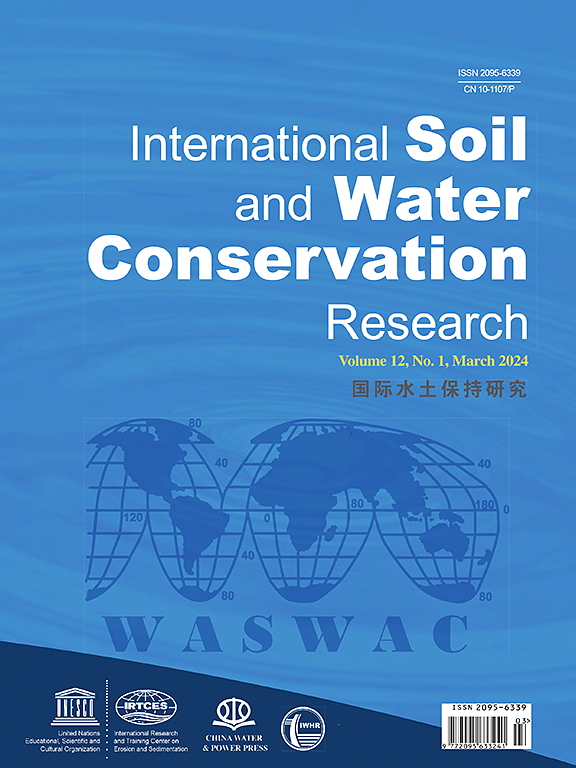Effect of rainfall intensity and gravel content on hydraulic characteristics and hydraulic parameters on soil erosion of spoil heaps: Laboratory experiments with simulated rainfall
IF 7.3
1区 农林科学
Q1 ENVIRONMENTAL SCIENCES
International Soil and Water Conservation Research
Pub Date : 2025-02-22
DOI:10.1016/j.iswcr.2025.02.005
引用次数: 0
Abstract
Spoil heaps represent one of the most severe forms of soil degradation and serve as significant triggers for geological disasters. To investigate the hydraulic characteristics of runoff and dynamical mechanisms of erosion on spoil heaps slopes, we conducted a series of simulated rainfall experiments under varying conditions: rainfall intensities (30, 60, 90, and 120 mm h−1) and gravel contents (0%, 10%, 20%, 30%, and 40%). The hydraulic parameters exhibited distinct patterns under different experimental conditions. These hydraulic parameters were positively influenced by rainfall intensity, gravel content, scouring time, and the interaction of rainfall intensity and gravel content, with gravel content showing the most significant impact. Under the experimental conditions, runoff on the spoil heap slopes manifested as rapid and laminar flow. The temporal evolution of the roughness coefficient paralleled that of the resistance coefficient. Exponential relationships were observed between hydraulic parameters and rainfall intensity, while quadratic relationships emerged between hydraulic parameters and gravel content in the soil-gravel mixture. The presence of gravel significantly altered the hydraulic characteristics of the spoil heaps slopes, with a critical threshold occurring at 20–30% gravel content. The Reynolds number (Re) and Froude number (Fr) demonstrated a negative logarithmic relationship (R2 = 0.472, P < 0.05), while Darcy-Weisbach resistance coefficient (f) and Manning roughness coefficient (n) exhibited a positive logarithmic relationship (R2 = 0.980, P < 0.01). Significant exponential relationships were found between f and Re, as well as between n and Re. Furthermore, power function relationships were established between Fr and f, and between Fr and n (R2 = 0.999 and R2 = 0.979, P < 0.01). The hydraulic parameters effectively predicted soil loss through power function. Fr, f, and n showed significant power function relationships with runoff rate, while Re demonstrated a highly significant linear relationship (R2 = 1.0). Among all parameters, Re exhibited the most stable relationship with both soil loss rate and runoff rate, making it the most suitable indicator for characterizing soil erosion. High gravel cover on slopes reduced the erosive effect of runoff. Under all rainfall conditions, hydraulic parameters influenced soil erosion more indirectly than directly, following the pathway: rainfall ➝ hydraulic parameters ➝ runoff ➝ soil erosion.
降雨强度和碎石含量对矸石堆水力特性及水力参数对土壤侵蚀的影响:室内模拟降雨试验
废土堆是土壤退化最严重的形式之一,是地质灾害的重要诱因。为了研究径流的水力特性和矸石堆坡面侵蚀的动力机制,我们在不同条件下进行了一系列模拟降雨实验:降雨强度(30、60、90和120 mm h - 1)和砾石含量(0%、10%、20%、30%和40%)。在不同的试验条件下,水力参数表现出不同的规律。降雨强度、含砾量、冲刷时间以及降雨强度与含砾量的交互作用对这些水力参数均有正向影响,其中含砾量的影响最为显著。在试验条件下,坡面径流表现为快速层流。粗糙度系数的时间演化与阻力系数的时间演化平行。水力参数与降雨强度呈指数关系,而水力参数与土-碎石混合体中碎石含量呈二次关系。碎石的存在显著改变了矸石堆边坡的水力特性,在碎石含量为20-30%时出现了一个临界阈值。雷诺数(Re)与弗劳德数(Fr)呈负对数关系(R2 = 0.472, P <;Darcy-Weisbach阻力系数(f)和Manning粗糙度系数(n)呈正对数关系(R2 = 0.980, P <;0.01)。f与Re、n与Re之间呈显著指数关系,Fr与f、Fr与n之间呈幂函数关系(R2 = 0.999、R2 = 0.979, P <;0.01)。水力参数通过幂函数可以有效地预测土壤流失量。Fr、f、n与径流率呈显著幂函数关系,Re与径流率呈极显著线性关系(R2 = 1.0)。Re与土壤流失率和径流率的关系最为稳定,是表征土壤侵蚀最合适的指标。坡面砾石覆盖高,径流侵蚀作用减弱。在所有降雨条件下,水力参数对土壤侵蚀的间接影响大于直接影响,其路径是:降雨、水力参数、径流、土壤侵蚀。
本文章由计算机程序翻译,如有差异,请以英文原文为准。
求助全文
约1分钟内获得全文
求助全文
来源期刊

International Soil and Water Conservation Research
Agricultural and Biological Sciences-Agronomy and Crop Science
CiteScore
12.00
自引率
3.10%
发文量
171
审稿时长
49 days
期刊介绍:
The International Soil and Water Conservation Research (ISWCR), the official journal of World Association of Soil and Water Conservation (WASWAC) http://www.waswac.org, is a multidisciplinary journal of soil and water conservation research, practice, policy, and perspectives. It aims to disseminate new knowledge and promote the practice of soil and water conservation.
The scope of International Soil and Water Conservation Research includes research, strategies, and technologies for prediction, prevention, and protection of soil and water resources. It deals with identification, characterization, and modeling; dynamic monitoring and evaluation; assessment and management of conservation practice and creation and implementation of quality standards.
Examples of appropriate topical areas include (but are not limited to):
• Conservation models, tools, and technologies
• Conservation agricultural
• Soil health resources, indicators, assessment, and management
• Land degradation
• Sustainable development
• Soil erosion and its control
• Soil erosion processes
• Water resources assessment and management
• Watershed management
• Soil erosion models
• Literature review on topics related soil and water conservation research
 求助内容:
求助内容: 应助结果提醒方式:
应助结果提醒方式:


